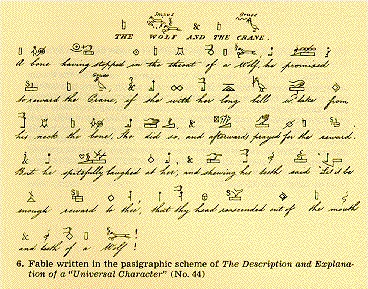Universal Writing (Pasigraphy)
THE DESCRIPTION AND EXPLANATION OF A "UNIVERSAL CHARACTER"
Bath [Eng.] J. Holloway [ca. 1835].
The author of this curious treatise describing a symbolic language is unknown. Published sometime in the 1830's, it attempts to reduce to a minimum the number of arbitrary symbols to be memorized. The author develops a pasigraphic scheme which employs pictographs to represent material things or terms derived from bodily organs and senses, and uses 24 arbitrary symbols to designate concepts such as size, direction, and quality, as well as to indicate the grammatical use to which a pictograph is put. The work concludes with a pictographic dictionary, and several examples of pictographic writing in the author's method. (BMC 51:579; NUC 140:311 (ND 0194916))
BENAJAH JAY ANTRIM (fl. 1843)
Pantography; or, Universal Drawings.
Philadelphia, Thomas, Cowperthwait & Co., 1843.
Antrim here proposes a scheme of universal language based upon sound. He advocates the use of a unique character or symbol to represent each sound made by men in their various languages, thus foreshadowing the so-called International Phonetic Alphabet now in use among linguists. Antrim argues that using such symbols as the basis for a common alphabet, the learning of different languages would be facilitated by requiring only a knowledge of the sense of the sounds in a given language. The work concludes with a comparative study of eastern and western written forms and alphabets. (NUC 18:231 (NA 0350252)
CAVE BECK (1623-1706?)
The Universal Character.
London, William Weekly, 1657.
One of several early efforts to develop a universal language, Beck's system is designed to be either written or spoken. It is based upon the use of Arabic numerals to express the radical works in any language, the key being a numerical glossary of the language being used. Letters of the alphabet are employed to express grammatical modification of any given word, while compound works are formed by the use of 200 connective characters. The work was published in French (1657). This copy ofUniversal Character comes from the collection of William Beckford (1760-1852), author of Vathek, from whom it passed into the library of his son-in-law, Alexander Douglas-Hamilton, 10th Duke of Hamilton (1767-1852). (Alston VII:286; Galland p.20; Stojan 33; Wstby-Gibson p. 20; Wing B1647)
CHARLES KASIEL BLISS (b. 1897)
International Semantography.
Sydney, 1948-49. 3 vols.
In Bliss' own words, this work is an attempt "to realise the dream of Descartes and Leibnitz of 300 years ago: simple, clear, non-ambiguous universal symbols for the whole range of language." Bliss bases his scheme on international symbols now used among scientists, such as Arabic numerals and chemical formulae, and on the widely used International Road Signs and Signals. He attempts to employ only those symbols which outline geometrically the things which they represent. That is, he puts forward a scheme which is almost entirely ideographic. A research chemist, Bliss also edits The Semantography Series (Sydney, 1949- ) for the Institute of Semantography. (NUC 61:266-67 (NB 0550952-53))
ANNE PIERRE JACQUES DE VISMES (1745-1819)
Pasilogie; ou, De la Musique, Considérée comme Langue Universelle.
Paris, Prault [etc.] 1806.
Anne Vismes, French composer and writer, here argues in favor of music as a form of universal writing. He claims that, in origin, language is essentially a musical form. For example, he points to the practice among ancient people of joining music and poetry, and claims that there is a relationship between letters, especially vowels, and the various musical scales used in the ancient world. Pasilogieargues that music has an infinitely greater capacity for expression through combinations of sounds and harmonies than has human speech. Vismes concludes his work by proposing the use of an enharhomic international alphabet of 21 letters for use in science, commerce, and politics. (BMC 249:727; LC 157:615; Stojan 568)
